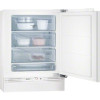AEG AGS58210F0 Product Manual - Page 10
Defrosting the freezer, Cleaning the air channels, Periods of non-operation
 |
View all AEG AGS58210F0 manuals
Add to My Manuals
Save this manual to your list of manuals |
Page 10 highlights
10 www.aeg.com The equipment has to be cleaned regularly: 1. Clean the inside and accessories with lukewarm water and some neutral soap. 2. Regularly check the door seals and wipe clean to ensure they are clean and free from debris. 3. Rinse and dry thoroughly. 4. If accessible, clean the condenser and the compressor at the back of the appliance with a brush. This operation will improve the performance of the appliance and save electricity consumption. 7.3 Defrosting the freezer CAUTION! Never use sharp metal tools to scrape off frost from the evaporator as you could damage it. Do not use a mechanical device or any artificial means to speed up the thawing process other than those recommended by the manufacturer. A temperature rise of the frozen food packs, during defrosting, may shorten their safe storage life. About 12 hours prior to defrosting, set a lower temperature, in order to build up sufficient chill reserve for the interruption in operation. A certain amount of frost will always form on the freezer shelves and around the top compartment. Defrost the freezer when the frost layer reaches a thickness of about 3-5 mm. 1. Switch off the appliance, or pull out electrical plug from the wall socket. 2. Remove any stored food, wrap it in several layers of newspaper and put it in a cool place. WARNING! Do not touch frozen goods with wet hands. Hands can freeze to the goods. 3. Leave the door open. In order to speed up the defrosting process, place a pot of warm water in the freezer compartment. In addition, remove pieces of ice that break away before defrosting is complete. 4. When defrosting is completed, dry the interior thoroughly. 5. Switch on the appliance. After three hours reload the previously removed food into the freezer compartment. 7.4 Cleaning the air channels 1. Remove the plinth (A), then the ventilation grid (B). C BA 2. Clean the ventilation grid. (Refer to "Cleaning the ventilation filter ". ) 3. Carefully pull the air deflector out (C), checking that there is no water left from the defrosting. 4. Clean the lower part of the appliance with a vacuum cleaner. 7.5 Periods of non-operation When the appliance is not in use for long periods, take the following precautions: 1. Disconnect the appliance from electricity supply. 2. Remove all food. 3. Defrost (if necessary) and clean the appliance and all accessories. 4. Leave the door/doors open to prevent unpleasant smells.















